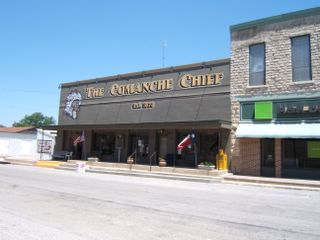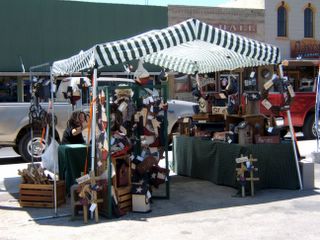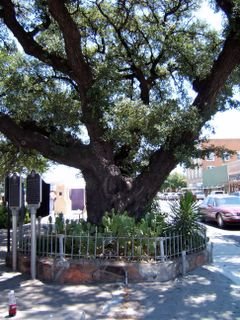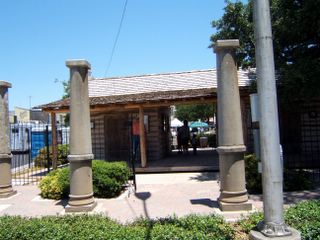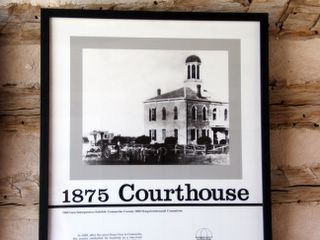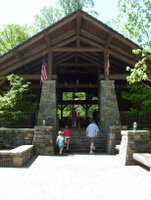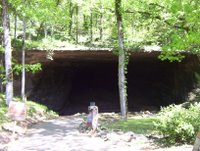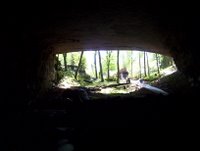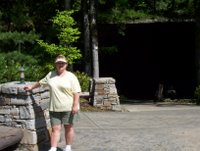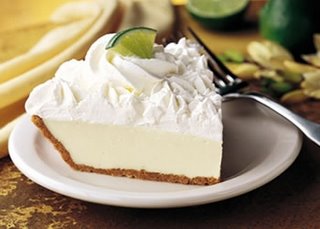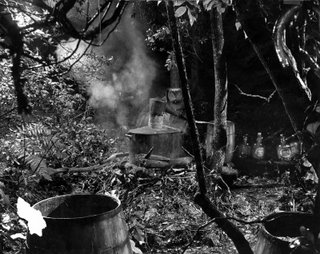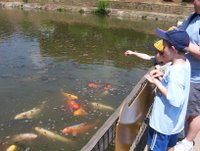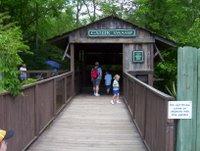
As much as corn being made into whiskey was a part of life in rural Madison County, so were all the many other ways corn was used to sustain life on the farm.
Nowadays, 90% of the corn produced in the United States is made into livestock and animal feed (notice the label on a can of cheap dog food). Back then, however, it was more like 75% family and 25% livestock.
We had a 10 acre field of corn, all green and yellow and blowing in the breeze. Cornfields were not very child friendly back then. From the time the field was plowed with a bull tongue plow to the time we shocked the fodder, it was a long spring, summer and fall. The cover crop was turned under when the weather first began to break in the spring. It was allowed to rest for a while before the disc harrow was used over and over again until the ground was soft and mealy and the consistency of ashes from a wood fire. It was between harrowings that the manure from the barn, saved in a huge pile through the winter, was spread over the field and worked in. I always think of the story of Harry Truman when I hear the word “manure”.
Bess Truman was a member of an elite Washington, D.C. area garden club. The Club had invited Harry to give a talk on gardening. During his speech, he made the comment about how manure worked in around your roses and other garden flowers would make the blooms much more prolific without the use of chemical fertilizer. After the meeting, some of the members of the club asked Bess if she would speak to Harry about his use of the word “manure”. It seemed inappropriate for their more affluent members. “I most certainly will not”, said Bess, “It has taken me 20 years to get him to say ‘manure’ “.
After the furrows were laid off, we came along and dropped the corn seeds by hand and covered them up with the soft dirt and a hoe. We waited patiently for the first green stalk to pop through the ground. It was along about this time that papa decided a big black crow should dedicate its life to being hung upside down in effigy on a pole to discourage all its kith and kin from flying down and pecking the freshly planted seed out of the ground. There was one on each side of the field as there was a slight rise in the middle of the field, so that you were not able to see clearly from one end of the row to the other. These effigies stayed by their watchful duties from the time the corn was planted until it came through the ground and then they went on to crow heaven. By that time, it was not only the crows that found it difficult to come about. After the green shoots were up about 6-8 inches high, it was time to till up between the rows with the horse and tiller tool. We followed along behind with a hoe to bring up fresh dirt around the stalk and dig up any weeds that were between the plants. Mama also had a 10 acre corn field when she was growing up.

She loved to tell the story of the time her and two of her sisters, Joncie and Nina Belle, and her older brother, Atley, were relegated to cornfield duty. Uncle Atley, being the youngest boy and granny Hunter’s baby, had hooked up the horse, Old Dan, and the tiller tool and was following along behind the plow loosening up the soil so the girls could pull the dirt and hoe the weeds. The girls would watch Uncle Atley and when he and Dan went over the rise in the field, they would pick up their hoes and run out the row to where they could see him again, stop and start hoeing again. This worked out pretty good, down one row and back the other way. Unbeknownst to them, granddaddy was watching the whole scene from the shade of the big oak tree. Granddaddy had had sunstroke and wasn’t allowed to be out in the hot sun for any length of time. As soon as all was finished and the horse and hoes put up, granddaddy made the girls take up their hoes and start the hoeing process all over again. From the bottom of the first row to the end of the last row, they had to hoe the field all over again. Mama said they never tried that trick again. Uncle Atley and granddaddy sat on the porch and drank cold spring water and watched the girls in the field in the hot sun, not only hoeing what they had missed by running, but what they had already hoed. Mama had told us this story often, so we didn’t even think about trying that trick.
We only planted field corn; we had not yet come into the age of silver queen, golden queen, Dairy Queen or drag queen. Field corn stalks were higher and stronger, and produced more ears than the modern corn varieties. There were usually 6-8 ears per stalk and, with the tassels, stood a proud 6-7 feet tall.
I usually never say never, but I have never been in a corn field that I did not get stung by a pack saddle, a caterpillar-like worm with a thousand legs, greenish yellow in color (like the corn) with a black, round dot on it’s back that looked exactly like a black saddle had been placed on there. This creature was pretty to look at, but carried the most vicious sting you have ever felt. I believe every one of its legs had some kind of toxin that made big red whelps on your skin everywhere it touched it. It burned like fire, itched, turned red and made your life miserable for a couple of hours after the deed had been done. Granny always wore a cotton dress, but when she worked in the corn field, under her dress she wore a pair of pants to cover her legs. She also wore a big flannel shirt to cover her arms and a bonnet to cover her head. As much as she urged us kids to do this and as many times as I got stung, you would think I would learn, but not. Still out there bare legged and bare armed with the green and yellow thousand legged critters just watching for me to enter their domain. Inevitably, when we got bit Granny would put wet snuff on the sting and tie it up with a rag. She dipped Garrett Sweet Snuff, which came in a green tin she always carried in her apron pocket.
In addition to children and packsaddles, there were other interesting creatures lurking in the cornfield. Whenever we saw a small harmless corn snake in the field, we went running and screaming to the house, only to be turned around and sent back into the field. We had an occasional ground hog or raccoon make its way through, but the dogs were usually right on top of that. We also kept guineas. These little pea hens were the best watchdogs. There was no such thing as an alarm system as long as these were around. They would set in to making noises like you have never heard and we knew something was up, so we usually kept most predators out of the cornfield one way or another.
Morning corn gathering was always bad as all was coated with the morning dew and you were soaking wet before you had gone past the first 4-5 stalks. I often wondered which was worse: being soaking wet, or waiting for the sun to bake the dew off and be out there in the boiling hot sun, with the corn blades scraping your skin and again making your life miserable, which all could have been avoided had I listened to granny and covered myself up in the first place!
The first corn that came in, the lower ears on the stalk, we gathered and used for canning: canned corn, corn chowder, pickled beans and corn and sometimes piccalilli. This was quite a summer full of work. We saved the green shucks to feed to the livestock; the fresh cobs were saved and fed to the hogs. When we would shuck the corn, the worms that were sometimes on the end of the corn under the tassels were reserved for throwing at one another just to hear a scream. Granny would go out into the field and peel back a part of the shuck and stick her thumbnail into one of the kernels. If it spurted forth juice, it was ready. She could tell exactly when the corn was right to be picked and canned. After we picked it, we shucked it and cut it off the same day, as granny said after the first day it would start losing its sugar and turn to starch. Some of the ears still on the stalk that had just passed the picking stage were used for gritted bread. The kernels had just started to dry up and get wrinkled, but still had a little juice in them. Granny would take the corn and rub it across a board with a piece of tin nailed to it. Nails had been driven through the tin and backed out so that the resulting holes had these sharp tines that allowed the corn to be grated. The entire ear was grated and there was just enough juice left in the ear to make the bread good and moist. Gritted bread is just about the best treat you can have with a big chunk of fresh butter and a red ripe tomato.
Here is a recipe for gritted bread should you be inclined to use your corn that has passed the just-ripe stage.
2 cups gritted corn
1/2 cup sweet milk
1 tsp. sugar
1 tsp. salt
2 Tbsp. soft butter
1/2 tsp. baking soda
1/4 cup flour
Mix ingredients together, adding flour as needed. Bake in greased iron pan at 400° for approximately 25 minutes.
The rest of the corn was allowed to dry on the stalk in the field. After all was dried, we would go through the field with the horse drawn wagon and collect the dried ears of corn. These would be carried back to the barn, shucked and put in the corn crib for feeding the livestock through the winter. Mama said they used the shucks to make mattresses, but that was before my time. I never slept on a corn shuck mattress. The corn stalks were cut and stacked teepee style in the field to be used for cow feed. This was called a fodder shock. The corn crib was close to the barn. It was about the size of two out houses with 2 inch boards nailed to the sides about 2 inches apart, so the air could get into the dried ears and keep them from molding. It had a tin roof (as did most of our out buildings). There wasn’t much playing around the corn crib as it was a haven for still more small critters that loved to eat the kernels. Some of the ears would be taken to the mill and cracked for chicken scratch feed, some would be ground at the mill to for corn meal and some would be ground into grits. The choice kernels granny would save to make hominy. Hominy is an acquired taste many have not been privileged to remember, but cooked correctly, it is a stick-to-your-ribs delicacy. The main step in making good hominy is the lye water used to soak the kernels in. Granny would burn only hickory to get her ashes for making lye to soak for the hominy. She kept it in a special bin and used it for only that purpose. She had a huge tin funnel and an enamel bucket. She put the ashes in the funnel and poured water through them and caught it in the bucket. When the water trickled through at the bottom, it was caught and poured back through the ashes until the lye water was as strong as she wanted it. She used this lye water to make hominy and homemade soap.
The next step was to soak dry corn in the lye water until the skin and the little "nib" at the point came off. This might take a day or two and the hominy was stirred occasionally during this time. When the skin would come off, the corn would be swelled to a certain extent to break those skins and then it was washed thoroughly, many, many times to remove all the lye. The last thing to do then was to cook the hominy until it was tender, cover it with a generous amount of butter, salt to taste and "dig in." Granny canned jars of this too to keep us through the winter.
The corn grinding mill is a story unto itself and I shall save that reflection for a later date. But for now, a corn mill story. One day, Granddaddy sent mama with two toe sacks of corn on old Dan to Silver’s Mill. The mill was at Petersburg and mama and her family lived at Bull Creek. Dan would usually not pay any attention to kids on his back, no matter how much they gooched him or kicked him in the flank. It probably felt no worse than a fly
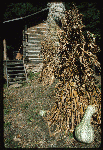
bite to him. Mama tried and tried to “giddy up” Dan and he just picked right on, taking his own sweet time. Uncle Arthur, granddaddy’s brother, came up behind Dan and hit him on the rump with a stick of stove wood and boy did he “giddy up” then. Mama was holding on for dear life and hollering, “whoa Dan! Whoa Dan!” But old Dan didn’t stop until he got all the way to the mill.
Until the day he died, Uncle Arthur always called Mama “whoa Dan!”
Well, I haven’t seen a packsaddle in a long time, I haven’t hoed a 10 acre field of corn in a long time (not at all nostalgic about that!), we no longer have a corn crib or grind our own corn, but I still have a special place I keep those wondrous memories from the cornfield and go back occasionally when it’s time for a pone of gritted bread.
__________________________________________
Written by: Judy Ricker
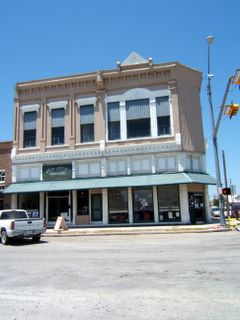 Corner where the old Jack Wright Saloon was and the site of Hardin's killing of Brown County Sheriff Charles Webb in 1874. Hardin escaped but a lynch mob killed his brother, Joe, who had never been guilty of anything criminal. I am fairly sure this is not the original building for the saloon, but it is the same corner. I do love the old architecture that Comanche citizens have managed to preserve around the square.
Corner where the old Jack Wright Saloon was and the site of Hardin's killing of Brown County Sheriff Charles Webb in 1874. Hardin escaped but a lynch mob killed his brother, Joe, who had never been guilty of anything criminal. I am fairly sure this is not the original building for the saloon, but it is the same corner. I do love the old architecture that Comanche citizens have managed to preserve around the square.